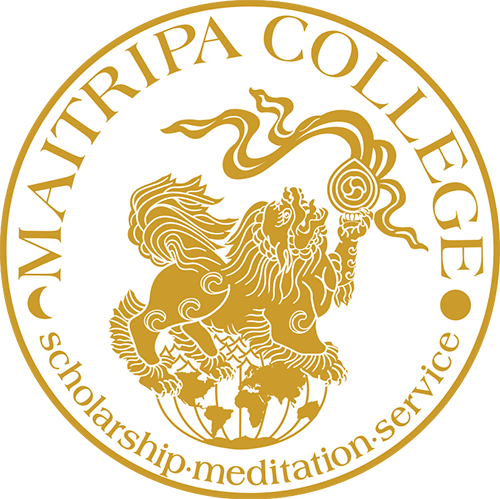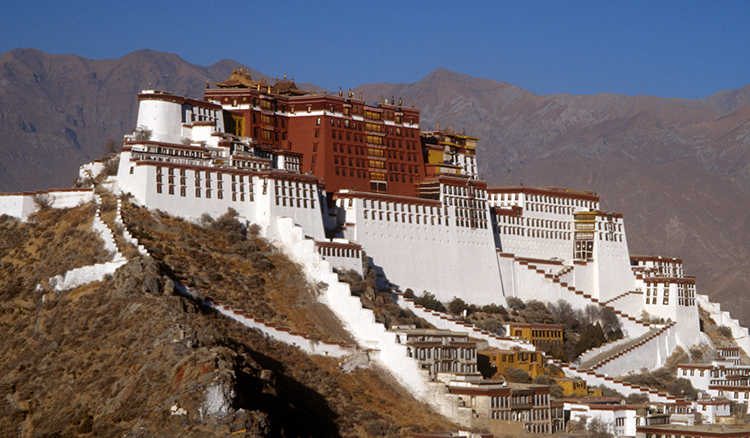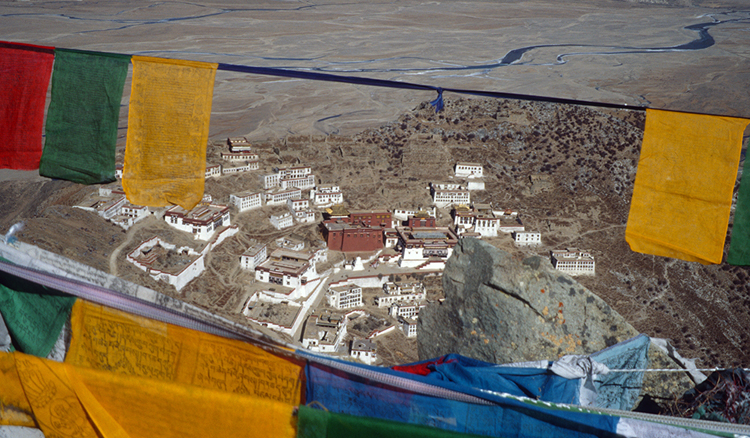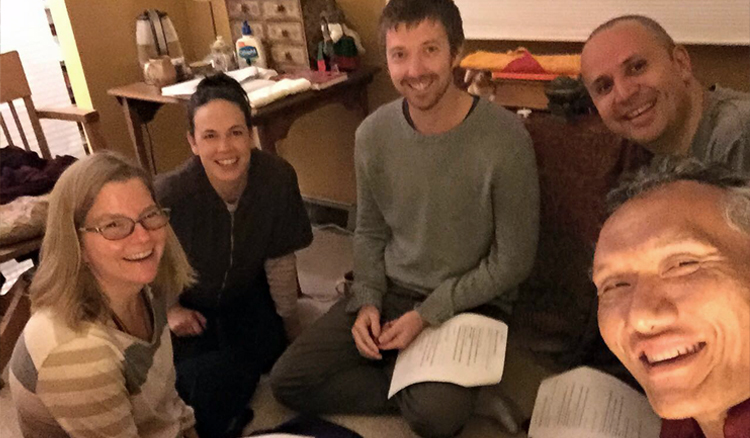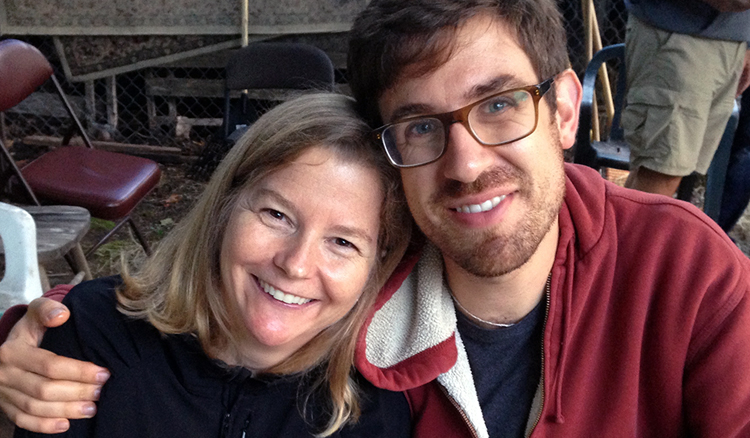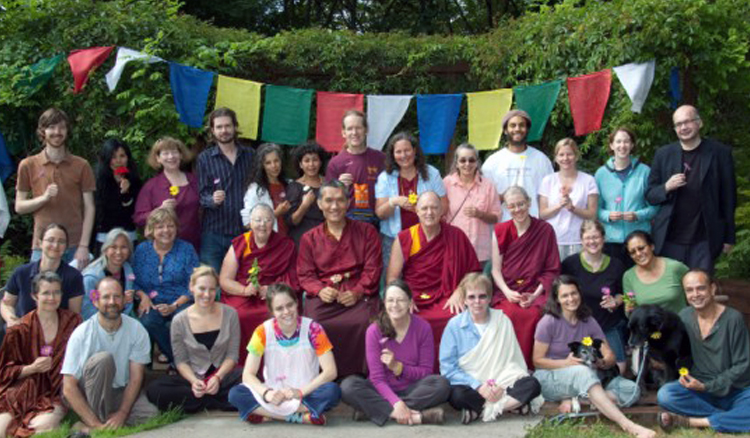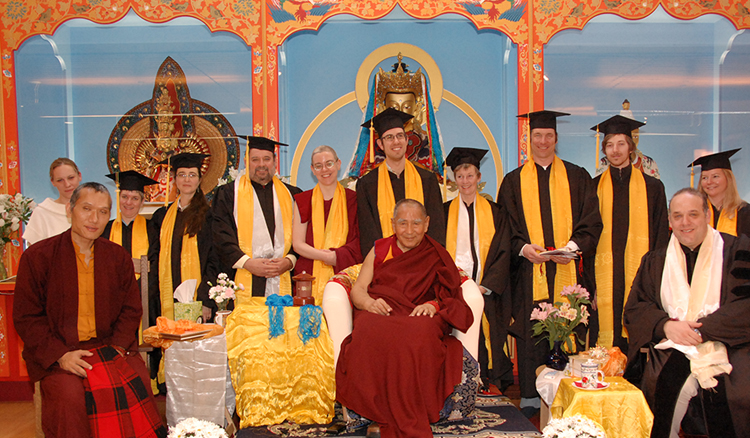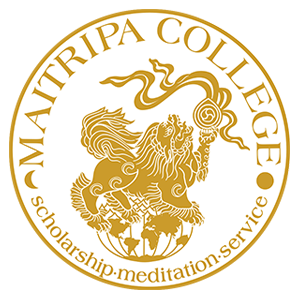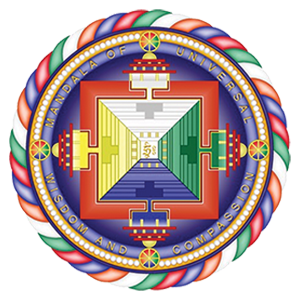An Interview with Jane Sellers, MA, 2009
Jane Sellers was among the first wave of students who moved to Portland in 2005 and 2006 to take part in an educational experiment: a new advanced program of Buddhist studies being developed under the guidance of Yangsi Rinpoche called Maitripa College. Jane graduated with a Master of Arts in Buddhist Studies from Maitripa in 2009. She moved back to Colorado in 2014 where she served from 2016-2019 as the study group coordinator and then center director (and one of the FPMT teachers) at Lama Yeshe House, Lama Zopa Rinpoche’s center in Denver.
“Jane embodies stability, dependability, and quietly achieving,” says fellow MA 2009 graduate Michael Jolliffe. “She’s followed all of her teachers’ advice in the best way. She’s done a lot of traditional practice, but also lived an ordinary life. She’s an example of spiritual maturity.”
Recently retired from her career as a physician assistant, Jane talked to Communications Coordinator Kate Macdonald about the Buddhist path, the benefit of Maitripa’s degree program, the role of travel and retreat in her life, and more.
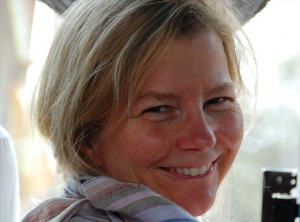
Jane on pilgrimage to Bodhgaya in 2008.
Kate: Jane, tell me a little bit about your background, how you ended up connecting with Buddhism, wanting to study the teachings, how you got to Maitripa.
Jane: Let’s see… Well, I moved to Boulder from Madison in 1988, but I was busy skiing, mountain biking, hiking, climbing—doing all that sort of stuff.
Then in 2000 I was 35 and in a long-term relationship, and we decided to quit our jobs and go traveling for a year. My partner had dabbled in meditation a little bit, and we both wanted to go to India; and he really wanted to go up to Dharamsala because he wanted to do a meditation course there. I thought: great, while you do that, I’ll go trekking.
We spent the first two months in India, in the Rajasthan area, where as a woman I was totally harassed—I dressed very conservatively, but nonetheless, it’s just the way it happens. Then in September when we arrived in Mcleod Ganj [a suburb of Dharamsala, home to His Holiness the Dalai Lama and the Tibetan Government in Exile], monsoon was supposed to be over, but it was still raining really heavily. And at that point I didn’t feel I could travel anywhere by myself—even though Mcleod Ganj is very different than where we had been in Rajasthan. I thought, well, what else am I going to do for 10 days? So, I went to the Intro to Buddhism course at Tushita [the FPMT center in Dharamsala].
I thought the course was interesting. And then my boyfriend decided to do the November course [the annual month-long course at Kopan, Lama Yeshe and Lama Zopa Rinpoche’s monastery in Kathmandu]. I thought there was no way I could sit for 30 days and the only reason I would be going is because he’s going, so instead I went off to China; he went to Kopan; and then we met up afterwards in Tibet, in Lhasa, in December.
And it was actually during our time there that I started thinking I really wanted to study the lamrim [Lama Tsongkhapa’s presentation of the Tibetan Buddhist path to enlightenment]. Lama Tsongkhapa Day happened while we were there with a lot of pilgrims coming into Lhasa, and there was just something very special about being there.
Kate: What was it about being in that environment, being in Tibet, that sort of opened your heart to Buddhism and made you decide you wanted to study?
Jane: I think traveling has the potential to open your heart to new experiences and ideas. Some people are really awestruck when they see the Taj Mahal—I was really awestruck when I saw the Potala Palace! There were throngs of pilgrims circumambulating the Jokhang [the famous temple in Lhasa] because of Lama Tsongkhapa Day and we circumambulated with the pilgrims and also went out to Ganden monastery. It was pretty powerful.
I remember going into the Jokhang and seeing the Jowo Rinpoche, the famous statue there of the Buddha in sambhogakaya aspect—but I didn’t know what I was looking at. The Jowo Rinpoche in Lhasa looks just like the one in the Jokhang at Maitripa!
Lama Zopa Rinpoche also talks about the power of holy objects, and I really believe that. I remember we got bonked on the head by a few holy objects while we were there. And it’s just… I don’t know … You go and you see these incredibly old, gorgeous statues and you see all the devotion of the pilgrims and you really feel that you’re in this very special holy place. I can’t tell you exactly why I got interested in studying after my time in Lhasa, but it just happened.
So, after our time in Tibet, my partner and I traveled for another six months and then went home to Boulder; and I started looking for a Buddhist group or Dharma center I could connect with. He liked Lama Zopa Rinpoche, so I checked out the FPMT website and the Discovering Buddhism at Home course was coming out. I ordered the videos and started listening to the teachings. After a bit, I started wanting to have a teacher.
I also have a travel bug and had looked at taking six weeks off work and going to Ladakh with a friend. But in the end she couldn’t go, so I thought, I wonder what Lama Zopa Rinpoche is up to?
Rinpoche was giving a teaching in Mongolia—the Enlightenment Experience Celebration—this was in 2004, and it was scheduled for the same time that I had taken off work. I decided, well, I’m going to see Lama Zopa Rinpoche and Mongolia! And I thought if I don’t like the retreat, I can always leave and go travel, so no problem.
Then on the way to Mongolia when I was in Seoul, in the South Korea airport, I looked over—I was so jet-lagged and tired and hadn’t slept—and I realized that’s Lama Zopa Rinpoche over there. I had a four-year-old kata from Nepal that I pulled it out, but it was so dirty and wrinkly that I didn’t offer it. But I happened to be on Rinpoche’s flight to Mongolia, so I was able to say hello to him.
I went to the teachings—they were four weeks—and Rinpoche gave the lung, [or transmission] of The Sutra of Golden Light, and I just couldn’t leave.
Kate: Why couldn’t you leave? What was so powerful about that experience?
Jane: Well, I think when Rinpoche gives the lung of a sutra it’s very powerful. It really penetrates and goes through your whole being. I remember sitting there listening to Rinpoche, and I thought, “This is so weird!” I’m sitting here listening to this transmission in Tibetan, which I don’t speak or understand, and Rinpoche’s going a mile a minute, reciting very, very fast. And how is somebody speaking this fast and in this language that I don’t understand and I’m totally into it? You know? I mean, most of the people in the world, if they saw what was going on, they’d think, what is going on here!? But I just loved it.
I met Justin [Jenkins, MA 2009] and Eamon [Walsh, MA 2012] there. Justin was living in Boulder and going to Naropa at the time. He told me, “We have this teacher coming to visit from Wisconsin so why don’t you email me when you get back?” When I got back to Boulder, he and Karl [Nhambu Bergh, MA 2011] were living just a couple of blocks away, and the teacher who was coming was Yangsi Rinpoche.
I think I had a half day off work, so I attended Rinpoche’s teaching for only the half day, but it was so nice.
Justin and Karl had a little lamrim study group which I went to. And then I think Rinpoche came back once or twice with Namdrol to Boulder, so I got to spend a little bit more time with them.
When they first talked about Maitripa, my first thought was “Oh, I don’t need a degree,” and dismissed it. But then I got to thinking about how I really wanted to study, and especially because of His Holiness the Dalai Lama—His Holiness always emphasizes how important it is to study when you attend his teachings.
There was also probably a little bit of momentum because Karl and Justin were moving to Portland to attend. But I also felt, after an experience I’d had with a controversial group in Denver, that I really trusted Lama Zopa Rinpoche, and Maitripa was part of Rinpoche’s organization, so Maitripa felt like this safe place.
And then the more I thought about it, the more I felt drawn to study there. I wanted to really focus and concentrate on study at that time.
I also remember, I think it was Geshe Tashi Tsering [former long-time resident teacher at FPMT’s Jamyang Buddhist Center in London] who visited Maitripa at one point. He talked about how sometimes people cherry-pick what teachings they’re going to go to, whereas Maitripa’s degree program provided the whole package, the whole container without missing anything.
Sometimes some of the classes weren’t so easy—they were difficult; and some of the scholastic articles that we had to review were really challenging for me. But in the end it gave me a sense of accomplishment, and gave me more confidence in the path.
Kate: I know you said you really wanted to study, but were you also seeking any kind of personal transformation when you decided to do the degree program?
Jane: I don’t know that I was overtly looking for personal transformation. I was coming to study, and I was really drawn—I had this strong draw to come. I did so many things in my life, but there was always something a little missing.
Kate: Could you talk a little bit about that? What it was that you felt was missing, and was that fulfilled by doing the degree program?
I read an article this morning that perfectly described it—how we’re taught from an early age to plan for the future. You plan to go to college, you plan to get a job, you plan to be happy after you’ve worked at your job, you plan to be happy after you meet somebody and get married and then have kids. And you’re always planning, planning, planning. But it’s almost as if you can’t be still in the moment and be happy. And looking at my life, you could say I did a lot of things: skiing, backpacking, hiking, mountain biking, all these things, but sometimes when I didn’t have something going on, I actually felt very alone, even when I was in a relationship. But Dharma has helped so much, I have to say that I feel I’m on the right path.
Kate: How do you feel your education at Maitripa benefited you? What’s the benefit of completing the degree program?
Jane: The degree program helped deepen the meaning and purpose of my life. I am not a scholar and thank goodness my classmates were because I learned a lot from them. I learned a lot from their questions, and they provoked me to think in different ways.
Kate: Could you talk a little bit more about that? Because you were already working in this caring profession, working as a physician assistant, helping people all day, every day.
Jane: Well, whatever job you’re in, you’re going to have interactions with others, and disturbing emotions are going to come up, and karma is going to ripen. So, the study and practice of Buddhism and trying to work with my mind has been so helpful when I meet with patients because challenging situations come up.
You’re dealing with people’s bodies, their health, and their minds. If they’re really hurting, some people can lash out; they’re scared. And Buddhist teachings gave me the tools to work with that. I don’t manage it perfectly, but Buddhism certainly gave me tools to be able to deal with high intensity people and situations. I found over time that compassion would arise more and more in these situations.
Kate: That makes sense. Is there a lot of burnout that happens? I read recently that doctors have the highest rate of suicide of any profession.
Jane: I don’t know about suicide, but caregiver burnout, definitely.
I think part of it is that it’s a model that really pushes people because you have to see a lot of patients in a short amount of time. And when someone has a health issue, oftentimes it’s something that takes more than 20 minutes. You can connect with patients on a human basis, but to really give people adequate time, it takes more than 20 minutes. So, you have all these constraints around you in the way that you care for patients that often leads to frustration because you can’t give people what they really need.
At the same time, you do develop these connections with people, helping them, and treating their illness and their pain, which is really rewarding.
Kate: What were some of your favorite classes at Maitripa?
Jane: I have to say the meditation classes were favorites as Rinpoche lead the classes. That’s really how I learned how to meditate. And to meditate with Rinpoche is—wow!
The community service part was also really rewarding. We had to look at different needs in the greater Portland community. I ended up doing secular meditation at a detention center for juvenile sexual offenders. I developed a lot of compassion working with them. These were all kids that had likely been abused themselves.
We also facilitated Discovering Buddhism up at the prison in Washington. It was pretty intense for me to go into an all-male prison. That was not something I would have necessarily signed up for, but I did because of the degree program. The guys were so appreciative, and I found it really fulfilling. So, I think the community service program as part of the degree requirement is really helpful. It pushed me outside of my comfort zone.
Kate: Were there any things that were really challenging for you as a student looking back on that you were able to overcome?
Jane: I had a lot of obstacles getting my PA work license and couldn’t start work for about six months or so. That was a big deal for me financially. But things worked out. I think there can be some obstacles that arise for people, and that’s probably okay. I think it’s sometimes inevitable that there are some obstacles when you make a big move like that, aspiring to direct your life towards Dharma.
Kate: Do you have any favorite memories of your time at Maitripa?
Jane: Hmmm… Yangsi Rinpoche had me drive Lama Zopa Rinpoche a couple of times when Rinpoche was teaching in Portland. That was really special. [Yangsi] Rinpoche always seemed to be looking for ways for students to participate and make merit. For instance, Rinpoche would look for different students to lead Lama Zopa Rinpoche into the gompa during the teaching events. You always had a sense of Rinpoche really caring for all the students.
Being able to offer service at Maitripa was really meaningful for me, too. Whether setting up for different events or other ways of supporting the community—it was always an opportunity to be part of something really good.
Kate: Did you make really close friends when you were here?
Jane: Yes—you end up having a real heart connection with people. With my friends from Maitripa—and I feel that way throughout FPMT—there’s a strong heart connection you have with others.
Kate: I feel the same way. Jane, could you talk a little bit about the role of retreat in your life? Because you’ve done quite a bit of retreat… Why do you choose to do that and what’s the benefit?
Jane: I actually haven’t done much retreat but hope to. When Maitripa started there were 10-day Mahamudra retreats with Rinpoche in the summer for a few years in a row; then there was a Tara retreat and a Chöd retreat. And I also attended a few group retreats outside of Maitripa, at FPMT centers in India and Europe.
The group retreats really helped me learn more about the practices. You can read about them in books but participating in those retreats just changed everything for me. The retreats opened up those practices for me and I felt really inspired.
I think retreat is the only way to see how really busy the mind is, and to let that go. I think it’s a way you can start to discover some inner stuff.
One of Maitripa College’s early 10-day summer Chöd retreats, in 2009. Chöd, which means “cut through the ego,” is a practice from the 11th century Tibetan yogini Machig Labdron. “Chöd cuts off the self-cherishing thought and ignorance, the greatest obstacles on the path to enlightenment,” says Lama Zopa Rinpoche.
Maitripa College’s first graduating class receive their Master of Arts in Buddhist Studies degrees in 2009 from Geshe Lhundub Sopa (center), revered Buddhist teacher and one of the first Tibetan Buddhist scholars to teach in a Western university. From left: Dean of Education Namdrol Adams, President Yangsi Rinpoche, Ann Kane (now Ven. Drolma), Rachel Ryer, Chuck Latimer, Gyalten Mindrol, Michael Jolliffe, Linda Marshall, Kenneth O’Brien, Justin Jenkins, Professor Jim Blumenthal (1967- 2014), and Jane.
Kate: I understand that while you were doing the degree program at Maitripa, and working, you were also doing early morning sessions and evening sessions and your preliminaries. How were you able to do all of that, Jane?
Jane: Well, the first semester of the tantric studies year, Yangsi Rinpoche had us do the Refuge ngondro. [Ngondro, or preparatory practices, consist of 100,000 repetitions of various Tibetan Buddhist practices to purify and stabilize the mind.] And I thought we had to get it done in the first semester. I think some people took longer but I wanted to finish. Then I started on another preliminary practice. I found over time if I pushed too much I would get burned out. It was a learning process.
Kate: Where you just trying to push too hard and do too much all at once?
Jane: Well, with my job, I had to push. I had to go from patient, to patient, to patient, with some people taking longer. Then the next person is waiting and they’re mad at you because you’re late. So, I had that energy of push, push, push, push during the day and then to push outside of work and in my practice just didn’t work, so I had to back off.
Kate: Was it ever really difficult to come back to work after doing a retreat or did you feel more integrated?
Jane: I’d always seem to be a bit jet-lagged coming back because I’d push it to the last minute. I have a hard time leaving retreats; I’m always disappointed when they end. Coming back to work would be great for a few weeks, but work was like being on a hamster wheel so I felt like any gains I might have made seemed to spin off a little bit. Maybe in reality they didn’t, but I would feel that way.
Kate: So, it only increased your desire to want to do retreat, to go deeper into those practices?
Jane: Yes, the wish was there. I enjoyed my life, but it’s always been on the horizon to try to do what Lama Zopa Rinpoche advises. But I have to say the early retreats, I did not have a good time.
Kate: Can you tell me a bit about that?
Jane: For example, when we did the early Mahamudra retreats. Oh! My body hurt! It was supposed to be a silent retreat and people were talking—my mind didn’t like that. No, it wasn’t easy.
Kate: But you still were attracted to retreat even thought it was challenging at first?
Jane: Yes. I find the difficulty with practice is when I try to squeeze it into my life rather than make space for it. I found it doesn’t really work long-term for me. When you’re working you don’t have that much time, but you have to make some space for it.
Kate: Do you think the role of serious lay practitioners is important for the development of Buddhism in the West? It seems so often in our tradition, like we’ve talked about before, ultimately if you really want to do deeply into practice, you ordain.
Jane: Yes, I think lay practitioners are very important. Not everyone wants to or has the karma to ordain. I think it’s really inspiring to have lay practitioners who have developed realizations. And maybe some people relate more easily to a lay practitioner—people have different karma.
Kate: How has your idea of what Dharma practice is evolved or changed over the years?
Jane: I think Dharma practice is about learning to have a really good heart and bringing that into every situation. You can do a lot of practice but if it’s not really changing you—and I’ve been there, done that, and still struggle with it—it’s not really practice. So, learning to really bring that good heart into everything I do, into my interactions with people. You can get really complicated about things, but I think it distills down to developing a good heart and that’s what all these practices ultimately are for.
Kate: Is there anything else you thought would be helpful to share with people about your experience at Maitripa?
Jane: It’s such a special opportunity to be able to go there. It can be hard to commit to something like the degree program, but it will pay out dividends.
